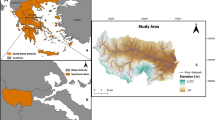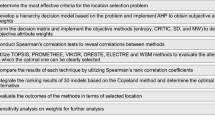Abstract
Marine pollution is an important environmental problem. One of the important causes of marine pollution is ship origin. This study deals with defining the importance degrees of ship origin marine pollution criteria. This paper suggests employing quality function deployment (QFD), interval type-2 fuzzy (IT2F) numbers, TOPSIS (technique for order performance by similarity to ideal solution) and SWOT analysis to determine these importance degrees. Internal factors, which indicate the strengths and weaknesses of the SWOT analysis in this paper, are the infrastructure of the sea to prevent pollution. External factors, which indicate the opportunities and threats of the SWOT analysis in this paper, are ship-related activities that cause pollution of the relevant sea. Five CRs and fourteen DRs are handled to examine ship origin marine pollution. Three experts have presented their judgments about the correlations and relationships of design requirements (DRs) and customer requirements (CRs). The proposed IT2F number-based QFD method uses IT2F numbers to determine the weights of DRs with the help of the correlations and relationships of the DRs and CRs. The most important internal factors are complying with the law and hard supervision, respectively. The most important external factors are direct discharge of waters of tank washing, direct discharge of ballast waters of ships and direct discharge of bilge waters of ships, respectively. Four seas are ranked in terms of ship origin marine pollution by using TOPSIS approach based on IT2F number. The most polluted sea exposed to ship origin marine pollution is Sea of Marmara according to the obtained results.

Similar content being viewed by others
References
Akao Y (1990) Quality function deployment: integrating customer requirements into product design, Taylor & Francis
Akbaş H, Bilgen B (2017) An integrated fuzzy QFD and TOPSIS methodology for choosing the ideal gas fuel at WWTPs. Energy 125:484–497
Al-Janabi S, Alkaim AF (2020) A nifty collaborative analysis to predicting a novel tool (DRFLLS) for missing values estimation. Soft Comput 24(1):555–569
Al-Janabi S, Mohammad M, Al-Sultan A (2020) A new method for prediction of air pollution based on intelligent computation. Soft Comput 24(1):661–680
Amin F, Fahmi A, Abdullah S (2019) Dealer using a new trapezoidal cubic hesitant fuzzy TOPSIS method and application to group decision-making program. Soft Comput 23(14):5353–5366
Bywater J (1995) Government response to marine pollution from ships. Mar Policy 19(6):487–496
Chang AY (2012) Prioritising the types of manufacturing flexibility in an uncertain environment. Int J Prod Res 50(8):2133–2149
Chen LH, Chen CN (2014) Normalisation models for prioritising design requirements for quality function deployment processes. Int J Prod Res 52(2):299–313
Dyson RG (2004) Strategic development and SWOT analysis at the University of Warwick. Eur J Oper Res 152(3):631–640
Efe B (2019a) Fuzzy cognitive map based quality function deployment approach for dishwasher machine selection. Appl Soft Comp 83:105660
Efe B (2019b) Analysis of operational safety risks in shipbuilding using failure mode and effect analysis approach. Ocean Eng 187:106214
Efe B, Efe ÖF (2021) Quality function deployment based failure mode and effect analysis approach for risk evaluation. Neural Comput Appl 33:10159–10174
Efe B, Yerlikaya MA, Efe ÖF (2020) Mobile phone selection based on a novel quality function deployment approach. Soft Comput 24(20):15447–15461
Efe B (2019) Website Evaluation Using Interval Type-2 Fuzzy-Number-Based TOPSIS Approach. In Multi-Criteria Decision-Making Models for Website Evaluation (pp. 166–185). IGI Global
Fahmi A, Amin F, Khan M, Smarandache F (2019) Group decision making based on triangular neutrosophic cubic fuzzy einstein hybrid weighted averaging operators. Symmetry 11(2):180
Fan C, Hsu CJ, Lin JY, Kuan YK, Yang CC, Liu JH, Yeh JH (2018) Taiwan’s legal framework for marine pollution control and responses to marine oil spills and its implementation on TS Taipei cargo shipwreck salvage. Mar Pollut Bull 136:84–91
Fan J, Yu S, Chu J, Chen D, Yu M, Wu T, Chen J, Cheng F, Zhao C (2019) Research on multi-objective decision-making under cloud platform based on quality function deployment and uncertain linguistic variables. Adv Eng Inf 42:100932
He L, Song W, Wu Z, Xu Z, Zheng M, Ming X (2017) Quantification and integration of an improved Kano model into QFD based on multi-population adaptive genetic algorithm. Comput Ind Eng 114:183–194
Hwang CL, Yoon K (1981) Multiple attributes decision making methods and applications. Springer, Berlin
Kang X (2020) Aesthetic product design combining with rough set theory and fuzzy quality function deployment. J Intell Fuzzy Syst 39(1):1131–1146
Lee LW, Chen SM (2008) Fuzzy multiple attributes group decision-making based on the extension of TOPSIS method and interval type-2 fuzzy sets. In Proceedings of the 2008 international conference on machine learning and cybernetic (pp. 3260–3265), Kunming, China
Li YL, Tang JF, Chin KS, Han Y, Luo XG (2012) A rough set approach for estimating correlation measures in quality function deployment. Inf Sci 189:126–142
Lima-Junior FR, Carpinetti LCR (2016) A multicriteria approach based on fuzzy QFD for choosing criteria for supplier selection. Comput Ind Eng 101:269–285
Onar SÇ, Büyüközkan G, Öztayşi B, Kahraman C (2016) A new hesitant fuzzy QFD approach: an application to computer workstation selection. Applied Soft Computing Journal 46:1–16
Peng D, Yang Q, Yang HJ, Liu H, Zhu Y, Mu Y (2020) Analysis on the relationship between fisheries economic growth and marine environmental pollution in China’s coastal regions. Sci Total Env 713:136641
Ramanathan R, Yunfeng J (2009) Incorporating cost and environmental factors in quality function deployment using data envelopment analysis. Omega 37(3):711–723
Song C, Wang JQ, Li JB (2020) New framework for quality function deployment using linguistic Z-numbers. Mathematics 8(2):224
Toptancı Ş, Erginel N (2017) Hata Türü Ve Etkileri Analizi Ve Kalite Fonksiyon Yayılımı İle Bir İnşaat Firması İçin Risk Değerlendirmesi [Risk assessment for a construction company with failure mode and effects analysis and quality function deployment]. Mühendislik Bilimleri Ve Tasarım Dergisi 5:189–199
Vazifehdan MN, Darestani SA (2019) Green logistics outsourcing employing multi criteria decision making and quality function deployment in the petrochemical industry. Asian J Ship Log 35(4):243–254
Wu SM, Liu HC, Wang LE (2017) Hesitant fuzzy integrated MCDM approach for quality function deployment: a case study in electric vehicle. Int J Prod Res 55(15):4436–4449
Wu SM, You XY, Liu HC, Wang LE (2020) Improving quality function deployment analysis with the cloud MULTIMOORA method. Int Trans Oper Res 27(3):1600–1621
Yu L, Wang L, Bao Y (2018) Technical attributes ratings in fuzzy QFD by integrating interval-valued intuitionistic fuzzy sets and Choquet integral. Soft Comput 22(6):2015–2024
Author information
Authors and Affiliations
Corresponding author
Ethics declarations
Conflict of interest
The authors declare that they have no conflict of interest.
Informed consent
Informed consent was obtained from all individual participants included in the study.
Additional information
Publisher's Note
Springer Nature remains neutral with regard to jurisdictional claims in published maps and institutional affiliations.
Rights and permissions
About this article
Cite this article
Efe, B., Efe, Ö.F. & Ishizaka, A. A model proposal to examine the effects of ships to marine pollution in terms of internal and external factors. Soft Comput 26, 2121–2134 (2022). https://doi.org/10.1007/s00500-021-06626-z
Accepted:
Published:
Issue Date:
DOI: https://doi.org/10.1007/s00500-021-06626-z




